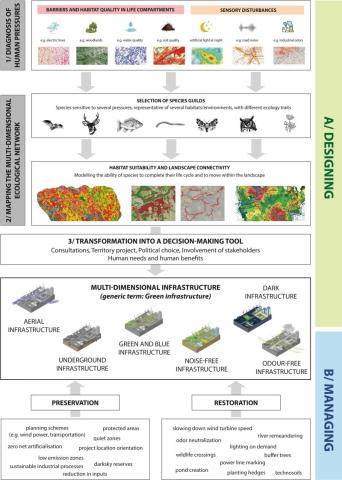To better preserve biodiversity on an international scale, an article published today in the journal Landscape Ecology calls for a broad rethinking of the concept of “ecological networks”, as well as the causes of their fragmentation and the means to preserve them.
As the authors (including our colleague Jérémie Cornuau) write, the notion of “ecological networks” has hitherto focused on the natural spaces on the Earth's surface (forests, grasslands, aquatic environments, etc.) and on the human disturbances that “physically” modify and fragment these environments (e.g. roads, dams, logging, etc.).
This approach neglects a significant proportion of ecosystem realities, such as soil biodiversity, the aerial movements of flying species, and the impact of light, noise and olfactory pollution linked to human activities.
The article therefore proposes to move on to a “multi-dimensional” conception of ecological networks. In France, the concept of a green and blue grid is based on the following elements (which, internationally, are grouped together under the term “green infrastructure”)
- "aerial" network , for flying species
- underground or “brown” network, for ground-dwelling fauna
- black" network, for nocturnal darkness
- silent or "white" network (in reference to "white noise")
- olfactory network, focusing on anthropogenic odors
To successfully integrate this multi-dimensional approach into territorial planning strategies, the authors recommend a multi-step approach:
- first, diagnose the quality of habitats and physical obstacles in all species' life compartments (aerial, terrestrial, aquatic, subterranean) at the scale of the area under study, and the disturbance factors that affect them (artificial light, road noise, industrial odors, etc.) ;
- select groups of species sensitive to several disturbances, representative of different habitats or environments, and with different life cycles ;
- model the life and movements of these species throughout the landscape (i.e., from the air to the subsoil), to produce a map of ecological networks that takes into account all the dimensions studied ;
- rely on concerted action and ambitious political support to transform these scientific results into a multi-dimensional ecological network, i.e., a strategic management tool on a territorial scale ;
- implement actions to preserve and restore ecological continuity.
